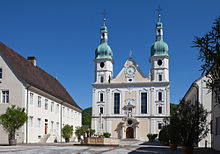Arlesheim Cathedral
The Arlesheimer Cathedral stands in the basel scenic community Arlesheim in Switzerland and was ordained 1,681th The church and the canons' houses on Domplatz were the seat of the cathedral chapter of the diocese of Basel from 1679 to 1792 . The cathedral has become the landmark of Arlesheim. The organ by Johann Andreas Silbermann from 1761 is also famous .
history
Expelled by the Reformation , the Bishop of the Duchy of Basel fled first to Altkirch , then to Pruntrut , in 1529 , whereas the cathedral chapter first went to Neuchâtel on the Rhine and was then accepted into the Basler Hof in Freiburg im Breisgau . After the French occupation of Freiburg, the Bishop and Chapter decided in 1679 to build a new residence in Arlesheim. The chapter could not be moved to Pruntrut, the seat of the Prince-Bishop, because the church belonged to the Archdiocese of Besançon and not to the Diocese of Basel. Arlesheim, on the other hand, was not only in the diocese, but also near Alsace , from where the chapter drew most of its income.
In 1792, during the French Revolution , Prince-Bishop Sigismund von Roggenbach fled into exile in Constance . In 1793 the last canons left Arlesheim and Freiburg im Breisgau became the official seat of the cathedral chapter again. The cathedral, the canon houses and the property were auctioned off and much was lost, including a. the church treasure , some bells and the ornate wrought iron choir grille . The cathedral has meanwhile been used as a storage room and even as a horse stable, and since 1812 it has been the parish church of the Arlesheim community.
architecture
The cathedral was built in 1679–1681 according to plans by Franz Demess, while the Misox master builder Jakob Engel (1631–1714) and his brother Karl were responsible for the canons' houses . On October 26th, 1681 the solemn consecration of the cathedral could take place, and in July 1682 the bells were raised.
The early baroque construction was very simple and strict. The unified room was accompanied by chapels, as it is today, and the walls were livened up by low galleries , such as those found in Jesuit churches. The central nave ended with an uninterrupted, wide apse rounding . Stucco work and heavy wreaths on the ceiling softened the sobriety of this room.
The cathedral church has two church towers, each of which is closed by a knob and a cross. The masonry is yellowish in color, framed by white frames; the tower is closed by a light green roof. In a niche above the front door made of light wood there is a statue of Maria with the child and the Basel staff , which is the coat of arms of the cathedral monastery.
Remodeling from 1759
The rapid construction around 1680 soon revealed severe damage, and in 1759, after only 80 years, extensive restoration was necessary. The cathedral was given a rococo look and was renewed inside and out and largely changed.
The architect was Franz Anton Bagnato (1732–1810). For performance of stucco and the high altar was Francesco Pozzi (1704-1789) responsible. The ceiling paintings and the frescoed altarpiece were made by Giuseppe Appiani . The carpentry work such as the main portal, the side doors with their carvings and the choir stalls were carried out by Peter Schacherer from Rheinfelden in 1761.
During the renovation, the cathedral was lengthened and the side entrances moved further towards the choir, the interior was slightly redesigned, the small galleries removed, and the cathedral received a crypt under the floor of the choir. The exterior of the church has also been redesigned, the facade made lighter by strengthening the vertical elements and embellished with additional flourishes on the windows.
In 1932 the interior and 1954/1955 the exterior of the cathedral church was renovated.
Silbermann organ
The organ is the last largely original Silbermann organ in Switzerland and is therefore a rarity. On November 2nd, 1759, the cathedral chapter commissioned the well-known master organ builder Johann Andreas Silbermann from Strasbourg to build an organ. This was built into the gallery above the entrance and completed on August 31, 1761. In 1962 a restoration was carried out by the Metzler Orgelbau company . In 1998 the organ was again fitted with a true-to-the-original Silbermann wedge bellows system. Another restoration was completed in June 2005. The instrument has the typical "bright" sound of a Silbermann organ, as was usual with a French baroque organ. The cornet registers are typical for this. She has the following disposition :
|
|
|
|
||||||||||||||||||||||||||||||||||||||||||||||||||||||||||||||||||||||||||||||||||||||||||||||||||||||||||||||||||||||||||||||
- S = Preserved registers from Andreas Silbermann 1761
The instrument was used for numerous LP and CD recordings, for example for the organ works by Johann Sebastian Bach by Walter Kraft , Karl Richter or Lionel Rogg . Richter's recording of Bach's six organ concertos (BWV 592–597), in which Bach arranged compositions by other composers, has become famous. Concerts are held regularly as part of the “Arlesheim Cathedral Concerts”.
Web links
- History of the parish of St. Odilia
- Catherine Bosshart-Pfluger: Franz Xaver von Mahler. In: Historical Lexicon of Switzerland .
Individual evidence
- ↑ Information on organ building in Arlesheim Cathedral
- ^ The organ by JA Silbermann , accessed on April 2, 2018 at: [1]
- ^ Johann Sebastian Bach: The 6 Organ Concerts BWV 592–597. Interpreter: Karl Richter at the Silbermann organ Arlesheim. Archive production, 9/1973.
Coordinates: 47 ° 29 '32 " N , 7 ° 37' 14.7" E ; CH1903: 613,726 / 260,178







